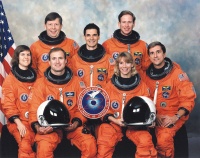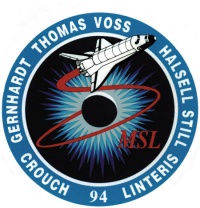STS-94
From The Space Library
 | |
| Organization | NASA-Office of Space Flight (United States) |
|---|---|
| Mission type | Human Crew |
| Launch date | July 1, 1997 |
| Launch vehicle | Space Shuttle |
| Launch site | Cape Canaveral, United States |
| COSPAR ID | 1997-032A |
| Experiments | Here |
| Alternate Names | 24849 |
| Additional Information | Here |
| Telecommunications Information | Here |
| Data Collection | Here |
| Payload Mass Up | 11597.45 kg |
STS 94 was a reflight of the STS 83 (97-013A) MSL mission, which was cut short due to a problem with Fuel Cell #2. It landed after just 3 day 23 hours. The primary payload on STS 94 was the Microgravity Science Laboratory (MSL), a collection of microgravity experiments loused inside a European Spacelab. It built on the cooperative and scientific foundation of the International Microgravity Laboratory missions IML-1 and IML-2, the US Microgravity Laboratory missions USML-1 and USML-2, the Japanese Spacelab mission, Spacelab-J, the Spacelab Life and Microgravity Science Mission, LMS, and the German Spacelab missions, D-1 and D-2. MSL featured 19 materials science investigations in 4 major facilities. These facilities were the Large Isothermal Furnace, the EXpedite the PRocessing of Experiments to the Space Station (EXPRESS) Rack, the Electromagnetic Containerless Processing Facility (TEMPUS) and the Coarsening in Solid-Liquid Mixtures (CSLM) facility. Additional technology experiments were also performed in the Middeck Glovebox (MGBX) developed by MSFC and the High-Packed Digital Television (HI-PAC DTV) system used to provide multi-channel real-time analog science video. The Large Isothermal Furnace was developed by the Japanese Space Agency and housed the Measurement of Diffusion Coefficient by Shear Cell Method Experiment, the Diffusion of Liquid Metals and Alloys Experiment, the Diffusion in Liquid Led-Tin-Telluride Experiment, the Impurity in Ionic Melts Experiment, and the Diffusion Processes in Molten Semiconductors Experiment. The Combustion Module-1 (CM-1) facility from the NASA Lewis Research Center housed experiments on Laminar Soot Processes Experiment and the Structure of Flame Balls at Low Lewis-number Experiment. The Droplet Combusion Experiment (DCE) was designed to investigate the fundamental combustion aspects of single, isolated droplets under different pressures and ambient oxygen concentrations for a range of droplet sizes varying between 2 and 5mm. The DCE apparatus was integrated into a single width MSL Spacelab rack in the cargo bay. The EXPRESS rack replaced a Spacelab Double rack and special hardware provided the same structural and resource connections the rack will have on the Space Station. It will house the Physics of Hard Spheres and the Astro/PGBA experiments. The Electromagnetic Containerless Processing Facility was used for the Experiments on Nucleation in Different Flow Regimes, Thermophysical Properties of Advanced Materials in the Undercooled Liquid State Experiment, Measurements of the Surface Tension of Liquid and Undercooled Metallic Alloys by Oscillating Drop Technique Experiment, Alloy Undercooling Experiments, the Study of the Morphological Stability of Growing Dendrites by Comparative Velocity Measurements on Pure Ni and Dilute Ni-C Alloy in the Earth and Space Laboratory Experiment, the Undercooled Melts of Alloys with Polytetrahedral Short-Range Order Experiment, the thermal Expansion of Glass Forming Metallic Alloys on the Undercooled State Experiment, the AC Calorimetry and Thermophysical Properties of Bulk Glass-Forming Metallic Liquids experiments and the Measurement of Surface Tension and Viscosity of Undercooled Liquid Metals experiment. The crew was the same as the STS 83 crew and consisted of the following: James D. Halsell - Mission Commander Susan L. Still - Pilot Janice E. Voss - Payload Commander Donald A. Thomas - Mission Specialist Michael L. Gernhardt - Mission Specialist Roger Crouch - Payload Specialist Greg Linteris - Payload Specialist

